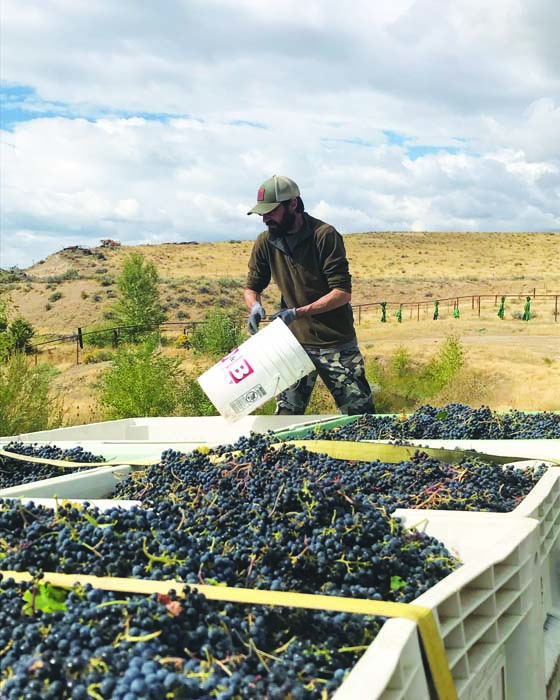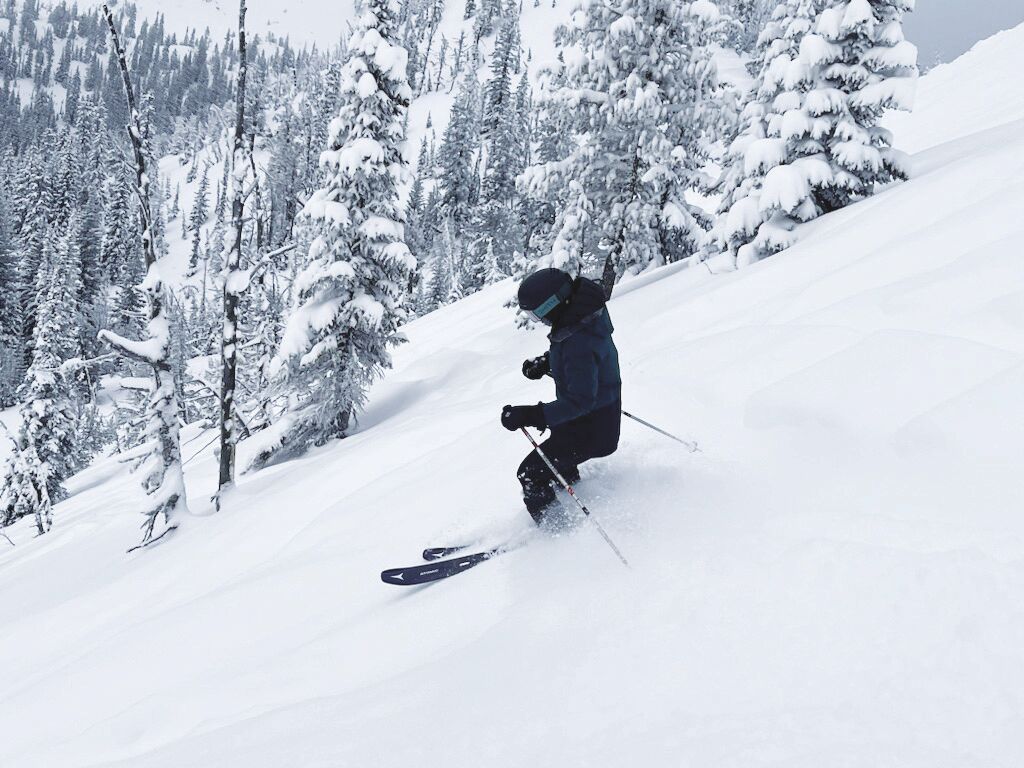AFTER THE STORM: Farmers say rain mainly beneficial
Published 3:05 pm Tuesday, August 22, 2023

- Travis Cook, owner of Copper Belt Wines in Keating, works on the grape harvest in 2022.
Jess Blatchford watched the progression of Hurricane Hilary with the trepidation unique to farmers, for whom weather can turn a bountiful field into a wasteland.
Trending
Blatchford, who grows potatoes, wheat and field corn in the Baker Valley, was optimistic about some free irrigation, to be sure.
But he also read forecasts that the hurricane’s remnants could spawn torrential rain at rates of 3 or 4 inches per hour — enough to potentially damage crops and leave fields as quagmires.
But the storm on Monday, Aug. 21, is likely to be mainly beneficial, Blatchford said on Tuesday afternoon.
Trending
Although the storm brought record-setting rain to much of Baker County, Blatchford said the steady but gentle showers didn’t pound crops the way the typical sources of August precipitation can — thunderstorms with cloudbursts or, even more feared, hail.
“At this point I don’t foresee any problems,” Blatchford said.
Rain can potentially harm wheat and other grains, he said. If the kernels are wet for an extended period they can germinate, which ruins the crop for anything but cattle feed, Blatchford said.
But he said that based on what he saw Tuesday, the risk is pretty low.
Blatchford said he was in the midst of harvesting wheat when the storm arrived Monday, and he’ll have to delay the harvest on some fields for a couple days while the wheat dries.
The forecast is promising, he said, calling for drier, warmer weather this weekend.
As for potatoes and corn, Blatchford was pleased with the rain.
“The potatoes are loving it,” he said. “It lets us get caught up on irrigation from last week’s 100-degree weather.”
Darrin Walenta, an agronomist with the Oregon State University Extension Service in La Grande, said Tuesday that he thinks the rain will help farmers and ranchers far more than it hurts.
The exception is for those who had hay on the ground.
That hay will need many days of dry, warm weather to be ready for baling, he said.
Walenta said the absence of widespread flooding, despite the record-setting rainfall, shows that the upper levels of soil are drier than usual.
“The ground is thirsty,” he said.
Chris Heffernan, who lives near North Powder and whose sons, Justin and Sheldon, grow a variety of specialty crops, said rain can potentially damage garlic by causing the membrane that holds the cloves together to slough away.
Less than an inch of rain isn’t likely to be a problem, though, Chris Heffernan said.
Most of the garlic grows in the Grande Ronde Valley, where rainfall was much less than in Baker County, with less than half an inch at the La Grande Ronde Airport.
Walenta, who lives in Union, said he measured 0.45 of an inch.
Focus of the storm
The heaviest rain fell in eastern Baker County.
A weather observer in New Bridge, about 3 miles north of Richland, measured 3.52 inches.
Renece Forsea, who runs a cattle ranch in Richland with her husband, Dan, said Dan, who grew up in Eagle Valley, had never seen a rainstorm, in more than half a century, to equal Monday’s.
The rain created a temporary lake that lapped at the wheels of their tractors and other equipment, Renece Forsea said.
She said the rain knocked down grass in one of their hay fields, which could lower the yield for the second cutting.
That harvest will be delayed for at least several days while the grass dries, she said.
Mib Dailey, a rancher who lives along Dry Gulch Road a couple miles west of Richland, said the storm’s timing was fortuitous in one sense. The second cutting of alfalfa is done and the second cutting of grass hay for the most part hadn’t started, he said.
Dailey said the rain should be a boon to local farmers and ranchers.
He expects the grass to grow rapidly with the unusual flush of late summer irrigation.
And field corn crops in Eagle Valley are “smiling,” Dailey said with a chuckle.
Both Dailey and Renece Forsea said flooding likely would have been more widespread except residents blocked water from flowing into several ditches. If the ditches were flowing throughout the storm, the addition of rain runoff could have caused many ditches to overflow, Forsea said.
Forsea said her husband had recently started diverting water from Crater Lake, in the Eagle Cap Wilderness north of Richland, to supply irrigation water to the Eagle Valley.
But for now, she said, “there’s plenty of water.”
Even without the addition of water from ditches, the rain was still too much for some drainage structures.
Dailey said a culvert beneath Dry Gulch Road couldn’t handle the volume, and the overflow formed a lake that extended into his horse pasture.
The water had receded by dusk on Monday, he said.
Riata Brown, who lives on a ranch in Richland and also works at Richland Feed & Seed, said she talked with several longtime Eagle Valley residents after Monday’s storm.
None, she said, “had seen anything like this.”
Brown said she heard of several Richland homes with flooded basements.
And on her ranch, runoff created a “sandbar” in one of their hay meadows.
But there was no major damage, she said, and the rain certainly eased any concerns about irrigation temporarily.
Not good news for grapes
Vintners are an exception to the rule that farmers in an arid land welcome late summer rain.
Travis Cook owns Copper Belt Wines in Keating Valley about 15 miles east of Baker City. He owns or manages three vineyards that supply grapes for the winery, two of 10 acres each in the Richland area, where the heaviest rain fell, and his original 3-acre plot, which he and his dad, Michael, planted in 2004, in Keating Valley about 2 1/2 miles north of the winery.
“In general, heavy rains this time of year are the worst nightmare,” Travis Cook said on Tuesday.
He said the harvest was set to start in about two weeks, although the rain could delay that schedule. He grows seven types of grapes, which ripen at different times, and the harvest continues into early October.
Rain can affect wine grapes in multiple ways — all of them negative.
In late summer, as the fruit is starting to turn color while it concentrates sugar, the grapes can absorb rain through their skin. This will dilute the flavor profile of this year’s wine vintage, Cook said.
Rain can also cause grapes to split, he said.
As the grapes ripen, the clumps get tighter, with less space between each, and rain creates an ideal situation for rot to form on the grape clumps, Cook said.
He’s dealt with rain in late summer before. In 2013 heavy rain fell in September.
The visual effects — grapes splitting or rot forming — can happen almost immediately, Cook said.
But the most important effect, on the flavor profile of the resulting wine, isn’t apparent until fermentation, he said.
Cook said the vagaries of weather don’t make him as anxious as they did early in his career as a vintner.
“I’ve been doing this for 20 years now and I’ve come to accept the terms of weather I have no control over,” he said.
“The potatoes are loving it. It lets us get caught up on irrigation from last week’s 100-degree weather.”
— Jess Blatchford, Baker Valley farmer
Baker City Airport: 1.4 inches
New Bridge (3 miles N of Richland): 3.52
Morgan Mountain (north of Huntington): 3.29
Oregon Trail Interpretive Center: 1.54
Blue Canyon (Old Auburn Road): 2.03
Elk Creek (near headwaters): 1.59
Baker Valley Agrimet (near Haines): 1.04
Hereford: 1.63
Yellowpine CG (northwest of Unity: 1.17









